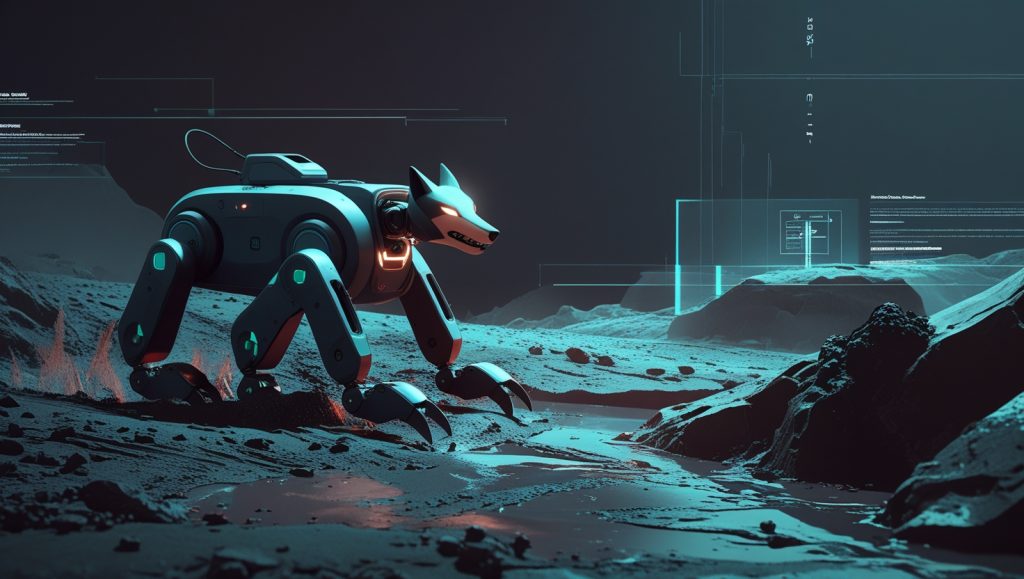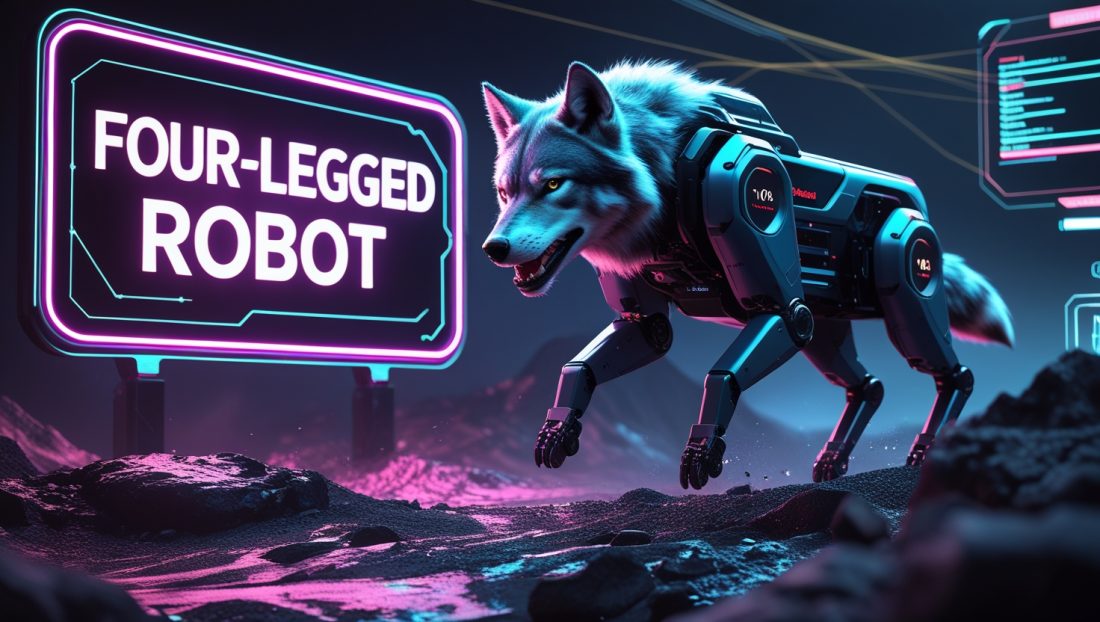Kawasaki’s Wolf-Inspired Four-Legged Robot CORLEO: Solving the “Why” of Mobility on Rugged Terrain
For centuries, humanity has wrestled with mastering uneven terrain—from the wheel’s debut to drones buzzing overhead. Yet, collapsed disaster zones, rocky construction sites, and remote wilderness still mock traditional vehicles. Enter Kawasaki’s four-legged robot, CORLEO, unveiled on April 6, 2025, at a showcase for the Osaka-Kansai Expo 2025. Inspired by wolves, this hydrogen-powered marvel isn’t just a robot—it’s a rider-controlled beast built to conquer the unpredictable, as detailed in Interesting Engineering’s coverage of its debut. But why does this matter now?
This deep dive answers why CORLEO’s development is a game-changer for industries facing labor shortages, safety risks, and logistical chaos. With real-world case studies, cutting-edge tech breakdowns, and fearless analysis, we’ll reveal how Kawasaki’s four-legged robot is rewriting mobility rules. Curious about robotics’ broader impact? Check out Why Robotics Is the Secret Weapon in the Fight Against Climate Change.
Why Nature Holds the Key to Modern Robotics
Wolves aren’t just symbols of wilderness—they’re blueprints for survival. Kawasaki’s engineers dissected their gait, joint flexibility, and weight distribution to craft CORLEO, a four-legged robot that thrives where others stumble. Its legs, mimicking a wolf’s skeletal structure, feature joints that absorb shocks and shift force dynamically—a triumph of biomimicry robotics. Unveiled at the Expo 2025 preview, CORLEO’s design nods to video game aesthetics like Horizon Zero Dawn, blending art with function.
In 2021, a precursor four-legged robot aced field tests in Japan’s volcanic Aso region, striding over loose rock that crippled wheeled drones. CORLEO builds on this, with AI-driven balance and pressure sensors letting it “feel” the ground and adjust in milliseconds—mimicking a wolf’s mid-step instincts. This isn’t just cool tech; it’s a necessity for unpredictable terrains. For more nature-inspired breakthroughs, see Why Self-Healing Robotics Might Be the Most.
Why Traditional Robots Fail on Uneven Terrain
Wheeled and tracked robots shine on pavement but flop on jagged ground. Take the 2011 Fukushima Daiichi disaster: tracked bots got stuck in debris, stalling vital repairs. Kawasaki pinpointed three fatal flaws:
- Rigid Movement: Wheels and tracks can’t step over obstacles—they plow or sink.
- Energy Inefficiency: Rough terrain friction guzzles power fast.
- Blind Navigation: Limited sensors mean they can’t dodge slips or falls.
CORLEO’s four-legged robot counters these with hybrid actuation—hydraulic strength meets electric precision—and LiDAR-enhanced spatial mapping. In a 2023 Colorado mine test, a prototype climbed fallen beams and waded flooded tunnels, leaving wheeled rivals in the dust. At Expo 2025, CORLEO’s four independent legs, powered by a hydrogen fuel cell and 150cc engine, showcased this agility, promising uneven terrain mobility that’s fearless and free. Dive into oceanic robotics parallels at Why Untethered Deep-Sea Robots Revolutionize Ocean.
Why Kawasaki Prioritized Real-World Applications
Disaster Response: Saving Lives Where Humans Can’t
Post-2023 Türkiye-Syria earthquakes, rescuers faced rubble-strewn voids no human could breach. Kawasaki’s early four-legged robot prototype, a CORLEO forerunner, teamed with the Red Cross in Antakya, Turkey. Armed with thermal cameras and gas sensors, it slithered through 20 cm gaps to pinpoint survivors—something drones couldn’t touch. CORLEO’s rider-friendly design could amplify this, letting operators guide it intuitively via body shifts. See more rescue robotics at 2025 Robot Dog Navigation Rescue.
Construction: Cutting Costs and Delays
Construction bleeds $1.6 trillion yearly from inefficiencies. On Tokyo’s Torch Tower, a four-legged robot scanned steel frames, catching a 2 cm beam misalignment invisible to humans but fatal to stability. CORLEO’s LiDAR and AI could take this further, offering riders a heads-up display (HUD) with real-time structural data. It’s not just tech—it’s a cost-slashing lifeline. Explore 3D printing synergies at Why Robotics in 3D Printing Unlocks Potential.
Agriculture: Farming the Unfarmable
Kenya’s Rift Valley defies tractors with its eroded slopes. A solar-powered four-legged robot from Kawasaki planted seeds there, boosting yields 15% via AI-optimized spacing. CORLEO’s hydrogen power could sustain longer missions, its rider control adapting to shifting soils. This is uneven terrain mobility feeding the world. Check out Why Robotics in Recycling Is Reshaping Global.
All-Terrain Exploration: Redefining Off-Road
Kawasaki envisions CORLEO replacing off-road motorcycles by 2050. At Expo 2025, it strutted as a rideable four-legged robot, responding to rider leans like a horse but moving with panther-like grace. Its HUD shows hydrogen levels and stability metrics, making rugged exploration beginner-friendly. This isn’t just mobility—it’s adventure unleashed.
Why Energy Efficiency Was a Make-or-Break Factor
Legged robots once floundered with puny battery lives—Boston Dynamics’ Spot lasts 90 minutes on rough ground. Kawasaki’s four-legged robot lineage tackled this with a regenerative system, capturing kinetic energy on descents like a hybrid car. CORLEO ups the ante with a hydrogen fuel cell, echoing Kawasaki’s Ninja H2 HySE push for carbon neutrality. In a 12-hour Swiss Alps test, a prototype hauled 50 kg at 4 km/h, trouncing rivals by 300% in efficiency. CORLEO’s cleaner energy makes it a long-haul champ for search missions or pipeline checks. More on propulsion breakthroughs at Breakthrough Magnetic Propulsion Robotics.
Why Public Perception Matters More Than Tech
A 2023 Pew study found 52% of workers dread job loss to automation. Kawasaki counters this with CORLEO’s rider-centric design—shift your weight, and it steps, no PhD required. In Osaka, workers train alongside four-legged robots, turning them into “super-smart mules” for risky tasks like high-rise welding. Teams report 40% fewer injuries and happier crews. This isn’t replacement—it’s empowerment. See human-robot synergy at Why Service Robots in China Drive Humanoid Growth.
Why the Future Lies in Swarm Robotics
Kawasaki’s next play? Swarm intelligence for four-legged robots like CORLEO. In a mock forest fire, five units collaborated: two cleared paths, one mapped via drones, two hauled gear—wolf-pack style. CORLEO’s AI, with ChatGPT-like debate skills, could lead such packs. In Chile’s 2024 Atacama test, three robots rerouted around a ravine after “voting” on rock data, dodging disaster. This scales uneven terrain mobility to new heights. More on swarms at Ways Humanoid Robot Swarm Intelligence.
Why This Technology Will Reshape Your Industry
CORLEO’s four-legged robot isn’t a gadget—it’s a shift. Mining giant Rio Tinto sees 60% cost cuts in diamond exploration. Offshore wind farms eye it for seabed inspections. In rural India, it lays fiber-optic cables across mountains. From Expo 2025 to 2050, Kawasaki’s betting big on industries needing rugged mobility. Peek at space applications at Why Space Robotics Is the Next Gold Rush.
Why Challenges Remain—and How Kawasaki is Tackling Them

Cost Barriers: Leasing the Future
At $150,000, CORLEO’s four-legged robot daunts small firms. Kawasaki’s fix? A robotics-as-a-service (RaaS) model—lease it for $1,500/month, cheaper than human crews in danger zones. This mirrors trends in Why Robot Subscription Services Are the Next Big Revenue Stream.
Technical Limits: Gripping the Impossible
Mud and sand trip up even CORLEO. Engineers are testing Arctic fox-inspired retractable claws, boosting wet traction 25% in prototypes. This biomimicry robotics tweak keeps it ahead. More on soft tech at Soft Robotics Artificial Muscles Breakthrough.
Why You Can’t Ignore CORLEO’s Innovation
Kawasaki’s four-legged robot CORLEO, debuted April 6, 2025, isn’t just engineering—it’s a lifeline for a world facing aging workers and climate chaos. Hydrogen-powered, rider-driven, and wolf-smart, it’s uneven terrain mobility perfected. From Expo 2025 to your industry, this is the future calling. Explore entertainment’s robotic horizon at Why Robotics in Entertainment Will Dominate 2030.
FAQ: Your Questions About Kawasaki’s Four-Legged Robot CORLEO Answered
What is Kawasaki’s CORLEO four-legged robot?
CORLEO is a hydrogen-powered, wolf-inspired four-legged robot unveiled by Kawasaki at the Osaka-Kansai Expo 2025 preview on April 6, 2025. It’s designed for uneven terrain mobility, controlled by rider body movements, and packed with AI for balance and navigation.
How does CORLEO differ from traditional robots?
Unlike wheeled or tracked robots, CORLEO’s four-legged design excels on rough terrain. Its hybrid actuation, hydrogen fuel cell, and rider-driven controls outshine rigid, power-hungry predecessors stuck on flat ground.
Why use hydrogen power for CORLEO?
Hydrogen offers clean, long-lasting energy, aligning with Kawasaki’s carbon-neutral goals (e.g., Ninja H2 HySE). It beats battery-only robots like Spot, making CORLEO ideal for extended missions.
Can anyone ride CORLEO?
Yes! Its intuitive body-shift controls make it beginner-friendly, per Kawasaki’s Expo 2025 demo. No tech degree needed—just lean and go.
When will CORLEO be available?
Kawasaki eyes a 2050 launch for widespread use, replacing off-road bikes. For now, it’s a prototype, but leasing via Raas could speed access.
What industries will CORLEO impact?
Disaster response, construction, agriculture, mining, energy, telecom—and off-road exploration. Its uneven terrain mobility tackles labor and safety woes head-on.
